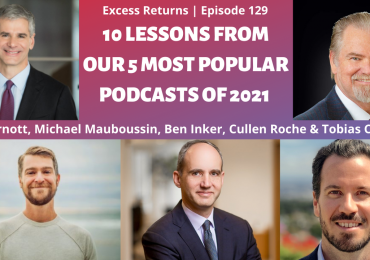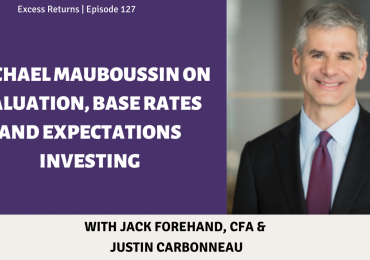By John Reese (@guruinvestor) —
Is it better to be lucky or smart? When it comes to investing, I think we can all agree that success arises from a combination of the two, but to what degree has been the subject of much debate.
Those who are well-studied in behavioral finance would tell you that investing is rife with the illusion of skill—an investor’s inflated, misplaced confidence in their own abilities to choose winning stocks. In fact, in his book Thinking, Fast and Slow, Nobel Laureate Daniel Kahneman makes the argument that much of the investment industry is built on such an illusion. He writes:
“Most of the buyers and sellers know that they have the same information; they exchange the stocks primarily because they have different opinions. The buyers think the price is too low and likely to rise, while the sellers think the price is high and likely to drop. The puzzle is why buyers and sellers alike think that the current price is wrong. What makes them believe they know more about what the price should be than the market does? For most of them, that believe is an illusion.”
Clearly, this is not meant to suggest that there are no skillful money managers or individual investors, but it is meant to underscore how difficult it is to measure how much skill translates into stock market gains. We know, for example, that there is no certain way to beat the market in the short run. Even if you manage to do so, that doesn’t mean you’ll do it again. The human brain, however, is masterful at attaching meaning to everything it experiences and to weaving those meanings into a narrative of its choosing. In a post from a few years ago, Ritholtz Wealth Management’s Ben Carlson offered a concise example: “When we have success in our lives we tend to attribute that success to skill or hard work. When something goes wrong and we fail, we attribute it to bad luck.” When choosing an asset manager, therefore, it might seem reasonable to make a decision based on a firm’s track record and return history. But is this really the best approach?
In his book The Success Equation: Untangling Skill and Luck in Business, Sports and Investing, author Michael Mauboussin explores the juxtaposition of luck and skill and their respective roles in investing. Results are persistent over time, he argues, only if performance relies primarily on skill. In an article from 2012, he wrote, “You can count on Yo-Yo Ma to play beautifully during his next cello concert because the outcome closely mirrors his skill every time he plays. But there’s no way to know for sure how Phil Ivey will fare in the next World Series of Poker because even if he plays his cards just right, he may suffer from awful luck.”
What, then, should be the focus when deciding where or with whom to invest? Since neither luck nor skill is easily measured, investors should focus on process. That is, you should start by setting forth goals and objectives and implement a clearly-defined, repeatable strategy that you can stick to. The investment strategies we use at Validea are inspired by the strategies of some of the most successful investors, including Warren Buffett, Peter Lynch and Benjamin Graham. These are process-driven strategies built on a solid foundation of financial data and focused on long-term results. By researching the investment techniques of these market gurus, we have been able to create systematic models that are able to filter stocks through a huge amount of market data to determine which pass muster under the various methodologies. Our models focus on a wide array of metrics, including the following outlined below, and these strategies are run through a highly disciplined, consistent and repeatable process.
- Debt: Most of our guru strategies include a metric related to a company’s debt, since high leverage can put a strain on cash flow and make earnings figures misleading.
- Price-to-Book Ratio: By comparing share price to a company’s book value you can get an idea of whether a stock is undervalued. While our various guru models might define book value slightly differently from each other, the basic idea is always to determine the true value of a business.
- Return-on-Equity: While there is no single, sure-fire way to ascertain whether or not a company has what Warren Buffett calls “durable competitive advantage,” companies that do have this distinction share a fundamental strength in return-on-equity. For Buffett, an ROE of greater than 15% indicates that management is doing a good job allocating retained earnings and is providing a solid, above-average return for investors.
- Relative Strength: This measures the price performance of a stock against the market as a whole. The higher the relative strength, the better the stock is performing relative to other stocks.
Whether you’re lucky or smart, a well-constructed investment process might be your best chance at generating returns above the market over time.
Photo: Copyright: everythingpossible/ 123RF Stock Photo
—-
 John Reese is founder and CEO of Validea.com and Validea Capital Management, LLC. Validea is a quantitative investment research firm and Validea Capital, a separate company from Validea.com, which maintains this blog, is a asset management firm offering private account management, ETFs and a robo advisor, Validea Legends and Validea Legends Income. John is a graduate of MIT and Harvard Business school, holder of two US patents and author of the book, “The Guru Investor: How to Beat the Market Using History’s Best Investment Strategies”. Follow John on Twitter @guruinvestor.
John Reese is founder and CEO of Validea.com and Validea Capital Management, LLC. Validea is a quantitative investment research firm and Validea Capital, a separate company from Validea.com, which maintains this blog, is a asset management firm offering private account management, ETFs and a robo advisor, Validea Legends and Validea Legends Income. John is a graduate of MIT and Harvard Business school, holder of two US patents and author of the book, “The Guru Investor: How to Beat the Market Using History’s Best Investment Strategies”. Follow John on Twitter @guruinvestor.









